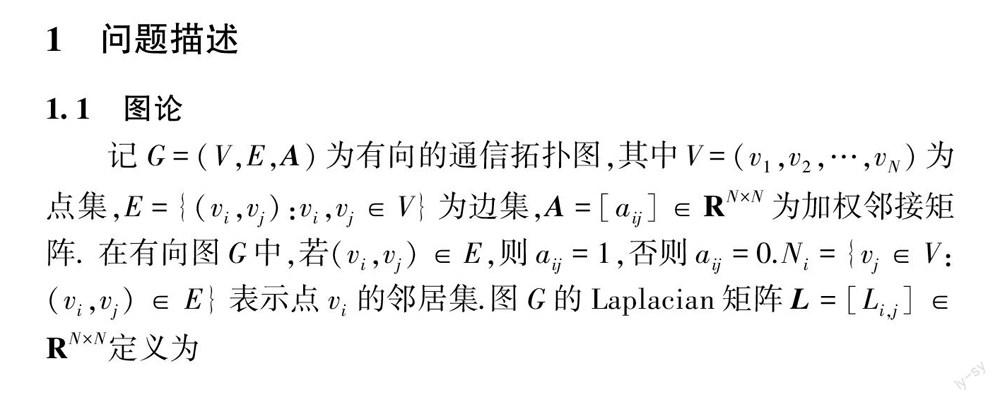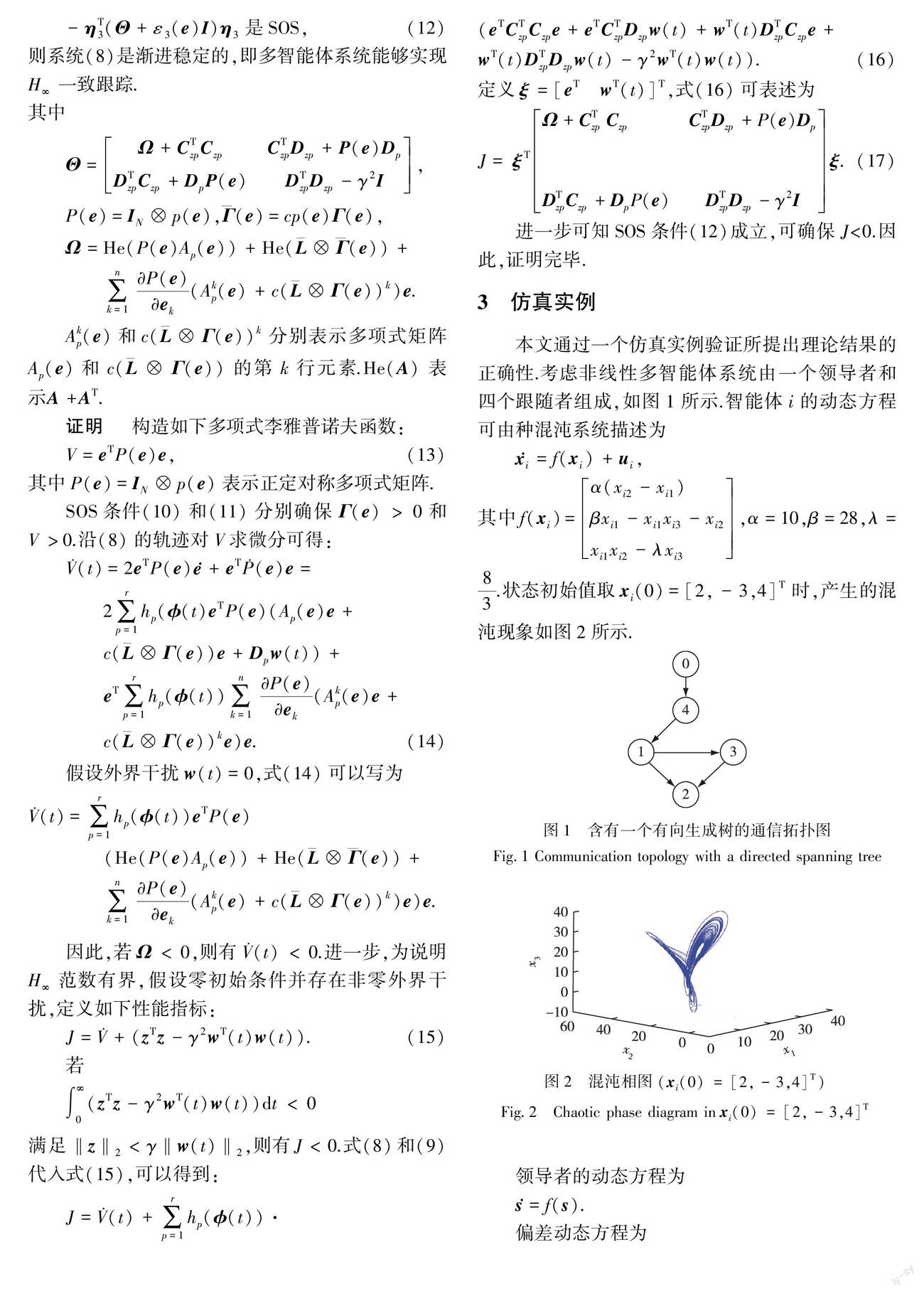模糊多智能体系统的H∞一致跟踪控制
于家凤 李沁生 邢文 韩春松 冯茂岩



摘要
本文研究非线性多智能体系统在有向拓扑下的领导跟随H∞一致性問题.首先,提出一种新的多项式模糊建模方法来描述由领导者与跟随者构建的偏差动态系统.然后,设计一致控制协议使跟随者渐近跟踪领导者的轨迹.基于多项式李雅普诺夫函数技术,提出松弛的渐近一致的充分条件并确保存在外界干扰时多智能体系统具有H∞抑制性能.将导出的条件转化为平方和形式并能够进行数值求解.最后,给出一个实例来验证所提出的一致控制协议的有效性.关键词
多智能体系统;模糊模型;H∞一致性;有向拓扑
中图分类号 TP273
文献标志码 A
0 引言
T-S模糊模型被认为是能够以任意精度逼近光滑非线性系统的一个有效工具[1-2],得到了广泛的关注[3-4].近年来,多项式模糊模型被提出用来建模非线性系统[5],可看作T-S模糊模型的一种推广.多项式模糊模型得到了广泛的关注,例如,采用平方和方法的多项式模糊控制系统的控制研究[6-7].
另一方面,由于多智能体系统广泛的应用性和显著的扩展性,多智能体系统的一致问题不断吸引着研究者们的兴趣,包括集群控制、群集控制、编队控制、复杂网络同步和通信网络的拥塞控制[8-9].采用多种控制方法以实现多智能体的一致,例如自适应控制[10-11] 、事件触发控制[8,12]、滑模控制[13]、H∞控制[7,14].特别地,文献[14]研究了T-S模糊多智能体系统在无向拓扑下的领导跟随H∞一致控制问题.文献[7]研究了多项式模糊多智能体系统在无向拓扑下的领导跟随H∞一致控制问题.为了在模糊模型中处理系统状态,文献[7,14]提出了一些严格的假设条件.
受文献[7,14]启发,本文研究非线性多智能体系统在有向拓扑下的领导跟随H∞一致性问题.首先,建立一个多项式模糊模型来描述领导-跟随构成的非线性多智能体系统,去除了文献[7,14]的一些假设条件.进一步,设计了一个新的控制协议以确保多智能体系统达到一致.将提出的多项式模糊模型应用于非线性多智能体系统的H∞一致控制问题,即在预设的一个H∞性能指标下,设计一个H∞控制协议以实现跟随者和领导者一致.基于多项式李雅普诺夫函数进行稳定性分析,推导出的多项式矩阵不等式条件转化为平方和(SOS)[15]的条件并进行数值求解.
4 结论
本文研究了有向拓扑下的非线性多智能体系统的H∞一致跟踪控制问题.首先,提出了一种新的多项式模糊建模方法来描述非线性偏差系统,推导出了基于SOS松弛的H∞一致的充分条件.本文所设计的状态反馈控制协议能保证多智能体系统实现渐近一致并满足设定的干扰抑制H∞性能指标.仿真实例验证了理论结果的有效性.
参考文献
References
[1]
Wang Y,Xia Y,Ahn C K,et al.Exponential stabilization of Takagi-Sugeno fuzzy systems with aperiodic sampling:an aperiodic adaptive event-triggered method[J].IEEE Transactions on Systems,Man,and Cybernetics:Systems,2019,49(2):444-454
[2] Wu Z G,Xu Y,Lu R,et al.Event-triggered control for consensus of multiagent systems with fixed/switching topologies[J].IEEE Transactions on Systems,Man,and Cybernetics:Systems,2018,48(10):1736-1746
[3] Fei Z Y,Shi S,Wang T,et al.Improved stability criteria for discrete-time switched T-S fuzzy systems[J].IEEE Transactions on Systems,Man,and Cybernetics:Systems,2019:1-9
[4] Shi P,Zhang Y,Chadli M,et al.Mixed H-infinity and passive filtering for discrete fuzzy neural networks with stochastic jumps and time delays[J].IEEE Transactions on Neural Networks and Learning Systems,2016,27(4):903-909
[5] Tanaka K,Yoshida H,Ohtake H,et al.A sum-of-squares approach to modeling and control of nonlinear dynamical systems with polynomial fuzzy systems[J].IEEE Transactions on Fuzzy Systems,2009,17(4):911-922
[6] Gassara H,El Hajjaji A,Krid M,et al.Stability analysis and memory control design of polynomial fuzzy systems with time delay via polynomial Lyapunov-Krasovskii functional[J].International Journal of Control,Automation and Systems,2018,16(4):2011-2020
[7] Tabarisaadi P,Mardani M M,Shasadeghi M,et al.A sum-of-squares approach to consensus of nonlinear leader-follower multi-agent systems based on novel polynomial and fuzzy polynomial models[J].Journal of the Franklin Institute,2017,354(18):8398-8420
[8] 許文盈,曹进德.基于事件驱动机制的多智能体系统协调控制研究综述[J].南京信息工程大学学报(自然科学版),2018,10(4):395-400
XU Wenying,CAO Jinde.An overview of recent progress in the study of event-triggered coordinated schemes of multi-agent systems[J].Journal of Nanjing University of Information Science & Technology (Natural Science Edition),2018,10(4):395-400
[9] 胡鸿翔,梁锦,温广辉,等.多智能体系统的群集行为研究综述[J].南京信息工程大学学报(自然科学版),2018,10(4):415-421
HU Hongxiang,LIANG Jin,WEN Guanghui,et al.A survey of development on swarming behavior for multi-agent systems[J].Journal of Nanjing University of Information Science & Technology (Natural Science Edition),2018,10(4):415-421
[10] Shi P,Shen Q.Observer-based leader-following consensus of uncertain nonlinear multi-agent systems[J].International Journal of Robust and Nonlinear Control,2017,27(17):3794-3811
[11] Wen G X,Chen C L P,Liu Y,et al.Neural network-based adaptive leader-following consensus control for a class of nonlinear multiagent state-delay systems[J].IEEE Transactions on Cybernetics,2017,47(8):2151-2160
[12] Zhang H,Yang R,Yan H,et al.H∞consensus of event-based multi-agent systems with switching topology[J].Information Sciences,2016,370/371:623-635
[13] Zhang J,Lyu M,Shen T,et al.Sliding mode control for a class of nonlinear multi-agent system with time delay and uncertainties[J].IEEE Transactions on Industrial Electronics,2018,65(1):865-875
[14] Zhao Y,Li B,Qin J,et al.H∞ consensus and synchronization of nonlinear systems based on a novel fuzzy model[J].IEEE Transactions on Cybernetics,2013,43(6):2157-2169
[15] Prajna S,Papachristodoulou A,Parrilo P A.Introducing SOSTOOLS:a general purpose sum of squares programming solver[C]∥Proceedings of the 41st IEEE Conference on Decision and Control,2002:741-746
Fuzzy-model-based H∞ consensus tracking
control of multi-agent systems
YU Jiafeng1,2 LI Qinsheng1,3 XING Wen4 HAN Chunsong5 FENG Maoyan1
1 School of Marine & Electrical & Intelligent Engineering,Jiangsu Maritime Institute,Nanjing 211170
2 School of Electrical and Electronic,The University of Adelaide,Adelaide SA 5005,Australia
3 School of Mechatronic Engineering and Automation/Shanghai Key Laboratory of
Power Station Automation Technology,Shanghai University,Shanghai 200072
4 College of Automation,Harbin Engineering University,Harbin 150001
5 School of Mechanical and Electrical Engineering,Qiqihar University,Qiqihar 161002
Abstract This paper is concerned with the H∞ consensus problem for nonlinear leader-follower multi-agent systems (MASs) with a directed communication network.A polynomial fuzzy modeling approach is proposed to describe the error system which is formulated by leader and follower agents.Then,the consensus control protocols are designed for MASs to enforce all the followers to track the trajectory of a leader asymptotically.Based on the polynomial Lyapunov function method,sufficient conditions are presented to ensure the consensus for MASs subject to external disturbances.The obtained conditions are converted into sum of squares and can be numerically solved.Finally,a simulation example is provided to demonstrate the effectiveness of the derived theoretical results.
Key words multi-agent systems;fuzzy modeling;H∞ consensus;directed topology
收稿日期 2020-03-02
資助项目 江苏省自然科学基金(BK20191457);江苏省现代教育技术研究课题(61980)重点项目;黑龙江省自然科学基金(F2017028);黑龙江省省属高等学校基本科研业务费科研项目(135109242,135409426,135409102)
作者简介于家凤,女,博士,研究方向为模糊控制与复杂动态网络系统.yyujie99@163.com
—— 瓮福集团PPA项目成为搅动市场的“鲶鱼”

